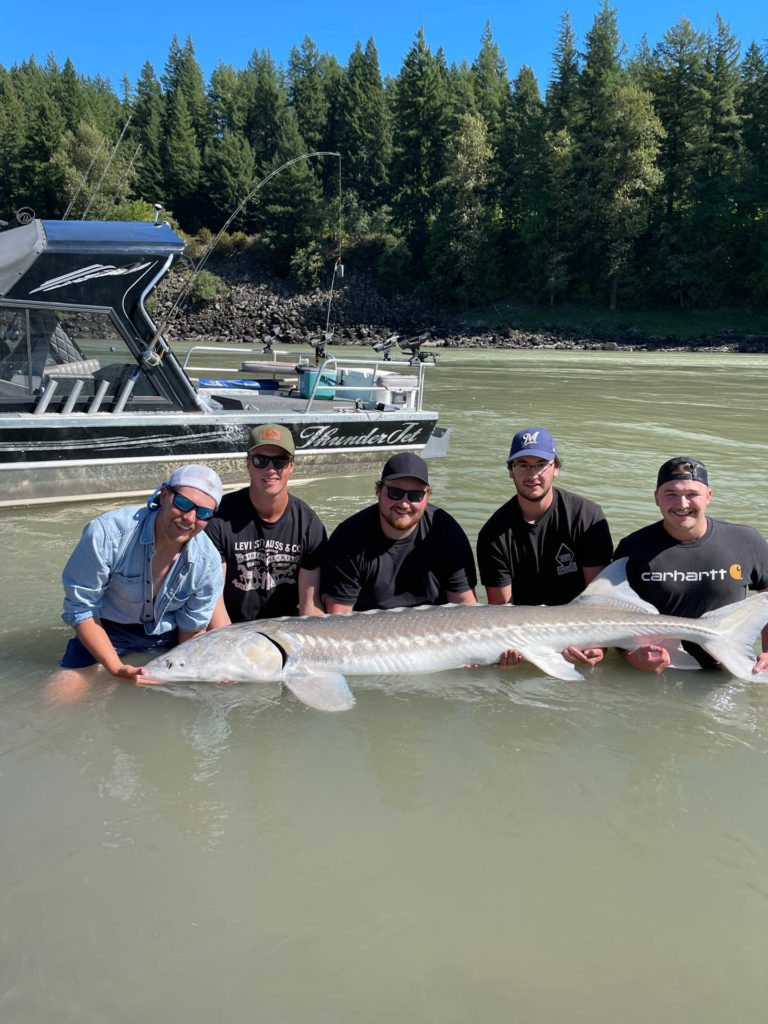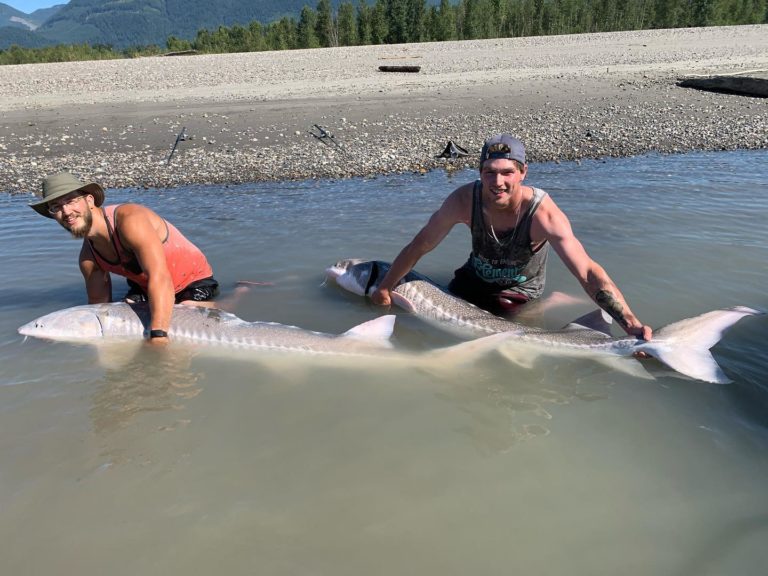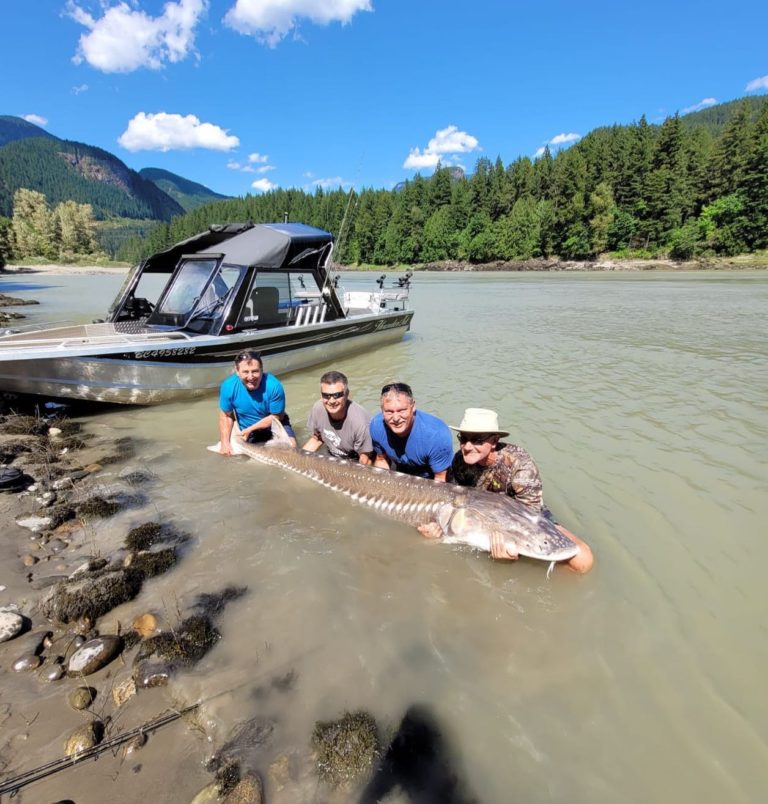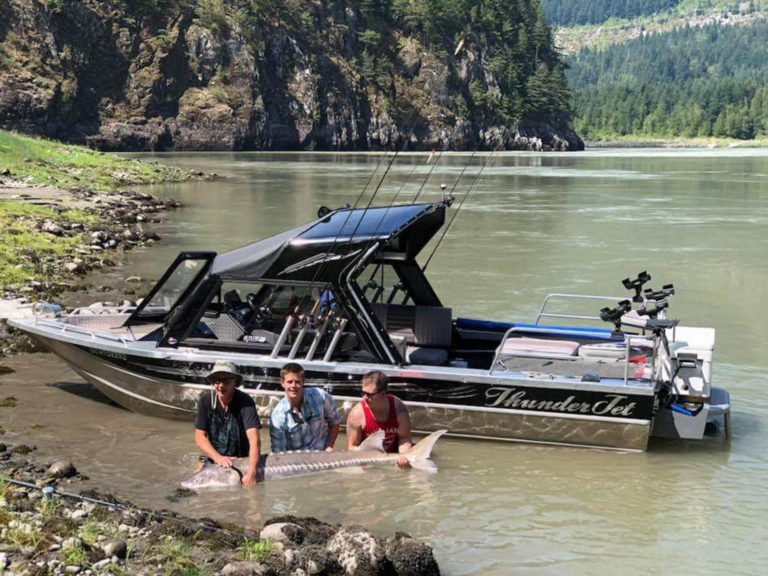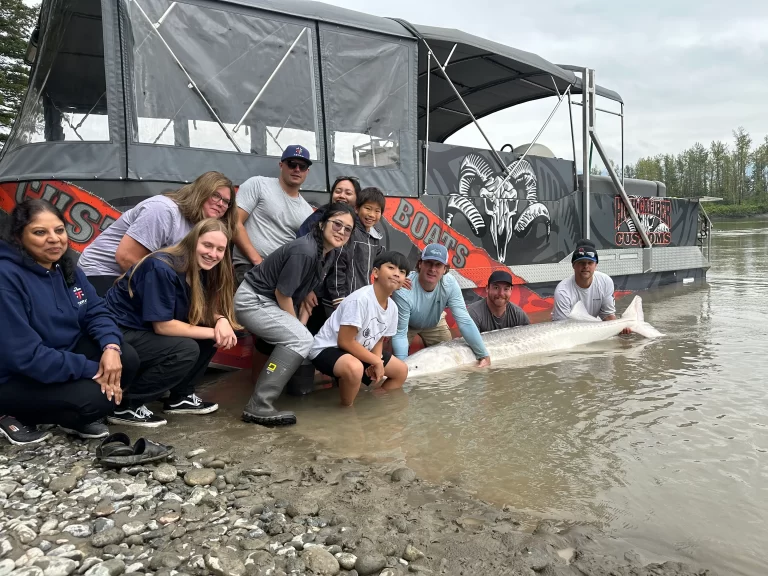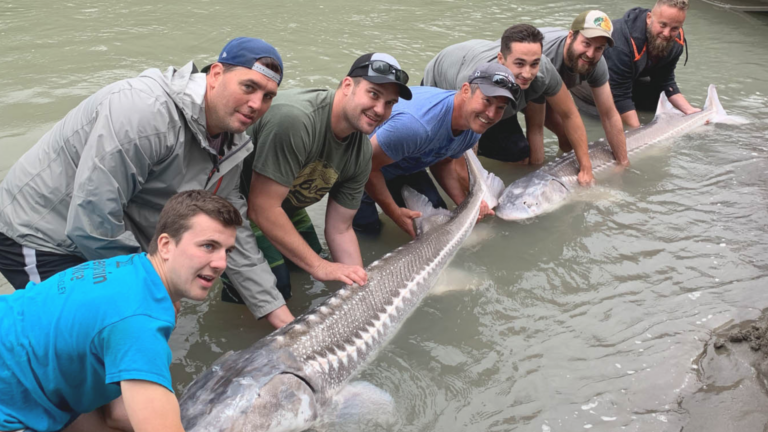The Ancient Giants of the Fraser River
The Fraser River is home to one of the largest populations of white sturgeon (Acipenser transmontanus), a prehistoric species that has survived for over 150 million years. These fish have witnessed the rise and fall of the dinosaurs, multiple ice ages, and countless environmental changes, yet they continue to thrive in these waters. As the largest freshwater fish in North America, Fraser River sturgeon can reach lengths of over 10 feet and weigh more than 1,000 pounds.
Unlike most fish, white sturgeon have cartilaginous skeletons, much like sharks, making them incredibly flexible and strong. They also lack traditional scales and have bony plates called scutes running down their bodies. With an average lifespan of 50 to 100 years, these giants have become an icon of the Fraser River, drawing anglers, conservationists, and researchers worldwide.
Indigenous Stewardship and Early Fishing Practices
Long before European settlers arrived, Indigenous communities such as the Stó:lō Nation, Secwépemc, Nlaka’pamux, and Tsilhqot’in had a deep connection with white sturgeon. These fish played an essential role in food supply, trade, and cultural practices, as First Nations relied on the river’s bounty for sustenance.
However, Indigenous fishing methods were rooted in sustainability. Traditional practices ensured that sturgeon populations remained stable, with fish being harvested only as needed and enormous breeding sturgeon often being released. Petroglyphs and oral histories from local First Nations groups depict white sturgeon as sacred creatures, reinforcing their spiritual and ecological significance.
The arrival of European settlers disrupted this balance. By the late 1800s, the demand for sturgeon caviar fueled excessive commercial fishing, leading to one of the most severe population declines in Fraser River history.
The Boom and Bust of Sturgeon Fishing
During the late 1800s and early 1900s, white sturgeon became the target of a highly profitable caviar trade. Fishermen harvested tons of sturgeon eggs to supply the growing international demand for caviar, leading to massive overfishing. The population nearly collapsed by the early 1910s, with numbers dropping so low that commercial sturgeon fishing in the Fraser River was no longer viable.
Realizing the severity of the decline, the Canadian government began implementing protective measures in the mid-1900s. However, it wasn’t until 1994 that a complete ban on commercial sturgeon fishing was enforced, marking a crucial step toward recovery. This moment in history sparked renewed conservation efforts, transforming the Fraser River into what it is today—the global leader in sturgeon conservation and sportfishing tourism.
The Turning Point: Sturgeon Conservation Efforts
With sturgeon populations at risk, the Fraser River Sturgeon Conservation Society (FRSCS) was established to monitor, protect, and restore white sturgeon populations. Their efforts, along with government agencies such as Fisheries and Oceans Canada and the BC Ministry of Environment, led to:
- The introduction of strict catch-and-release regulations
- Tagging programs to track sturgeon movements and survival rates
- Public awareness campaigns promoting responsible angling
Today, Fraser River sturgeon is one of the best-monitored freshwater fish species in the world, with thousands of fish tagged and studied over the years. Conservationists continue to work alongside local anglers to ensure that the sturgeon population remains stable for future generations.
The Science Behind Sturgeon Conservation
Modern conservation efforts rely on cutting-edge technology to track and study white sturgeon populations. Two primary methods are used for monitoring:
- PIT Tagging: A small Passive Integrated Transponder (PIT) tag is inserted beneath a sturgeon’s skin, allowing scientists to identify individual fish and monitor their growth over decades.
- Acoustic Telemetry: This method uses underwater tracking devices to follow sturgeon migration patterns and habitat preferences in real time.
Research has also focused on habitat restoration, improving spawning grounds, and identifying climate change and pollution effects on Fraser River sturgeon populations. Conservationists have worked to mitigate challenges such as water level fluctuations, agricultural runoff, and habitat degradation, all impacting sturgeon survival.
Fraser River’s Sturgeon Fishing Boom
The success of conservation efforts has helped transform the Fraser River into a world-class sturgeon fishing destination. With the commercial ban in place, catch-and-release sportfishing has flourished, attracting anglers from across the globe.
Thousands of visitors travel to the Fraser River each year to experience the thrill of battling a massive white sturgeon, some weighing over 500 pounds. This growth in sturgeon sportfishing has led to:
- A booming local tourism industry that supports guides, lodges, and outfitters
- Greater public awareness and funding for conservation efforts
- Increased scientific research opportunities, supported by angler participation
Sportfishing has revived interest in white sturgeon and helped generate economic benefits for local communities, proving that conservation and tourism can work hand in hand.
Meet the River’s Most Legendary Sturgeon
Among the thousands of sturgeon tagged in the Fraser River, one stands out—Pig Nose. First identified over a decade ago, Pig Nose is a massive white sturgeon recognized by a distinctive snout injury. This fish has been caught and released multiple times, providing invaluable data to researchers tracking its growth and migration.
Stories like Pig Nose’s highlight the success of conservation efforts and the importance of responsible angling. By ensuring these giants are safely handled and released, anglers contribute to sturgeon research and long-term population stability.
The Role of First Nations Gill Nets in Sturgeon Conservation
While conservation efforts have significantly improved white sturgeon populations, concerns remain about incidental bycatch from First Nations gill nets used for salmon fishing. Gill nets are designed to target specific fish species but can unintentionally entangle and injure sturgeon, posing a risk to their survival.
Efforts are underway to address this issue while respecting Indigenous fishing rights. Conservation groups and First Nations communities are collaborating to develop alternative fishing methods, improve net placement strategies, and increase awareness about minimizing harm to sturgeon. By working together, it is possible to balance cultural traditions with conservation goals to protect the future of Fraser River sturgeon.
How You Can Support Fraser River Sturgeon Conservation
Protecting white sturgeon requires community involvement. Whether you are an angler, conservationist, or visitor, there are several ways to contribute:
- Report Tagged Sturgeon: If you catch a sturgeon with a PIT tag, record the tag number and report it to local conservation groups.
- Practice Responsible Catch-and-Release: Follow ethical handling guidelines to minimize stress and injury to the sturgeon.
- Donate to Conservation Programs: Organizations like the Fraser River Sturgeon Conservation Society rely on funding for research and habitat restoration.
- Volunteer for Sturgeon Research Projects: Many programs allow anglers to assist with sturgeon tagging and monitoring efforts.
- Educate Others: Spread awareness about the importance of sturgeon conservation and encourage ethical angling practices.
By prioritizing sustainable fishing practices and scientific research, the Fraser River has become the global leader in sturgeon conservation, ensuring that these prehistoric giants thrive for future generations.
Final Thoughts
The transformation of the Fraser River into the world’s sturgeon capital is a testament to the power of conservation, responsible angling, and community engagement. From its Indigenous heritage to the modern catch-and-release movement, the story of Fraser River sturgeon is one of resilience and renewal.
Through ongoing research, eco-tourism, and public involvement, the Fraser River remains one of North America’s last great strongholds of white sturgeon. By respecting and protecting these incredible fish, future generations will have the chance to experience the thrill of sturgeon fishing and witness the legacy of this prehistoric species.
Frequently Asked Questions
What makes Fraser River the best location for sturgeon fishing?
Fraser River is home to one of North America’s largest white sturgeon populations. Its deep pools, strong currents, and abundant food supply create the perfect habitat for these prehistoric fish. Strict catch-and-release regulations and ongoing conservation efforts have helped maintain a thriving sturgeon population, making it a top destination for anglers.
How does sportfishing contribute to sturgeon conservation?
Catch-and-release sturgeon fishing plays a vital role in conservation by promoting responsible angling practices and funding research initiatives. Many fishing guides participate in tagging programs that help scientists track sturgeon movements, health, and growth. Additionally, revenue from sportfishing tourism supports local conservation efforts and habitat restoration projects.
What should I do if I catch a tagged sturgeon?
If you catch a tagged sturgeon, record the tag number, its approximate length, and the location where it was caught. Report this information to the Fraser River Sturgeon Conservation Society or Fisheries and Oceans Canada. This data helps researchers monitor sturgeon populations and improve conservation strategies.

